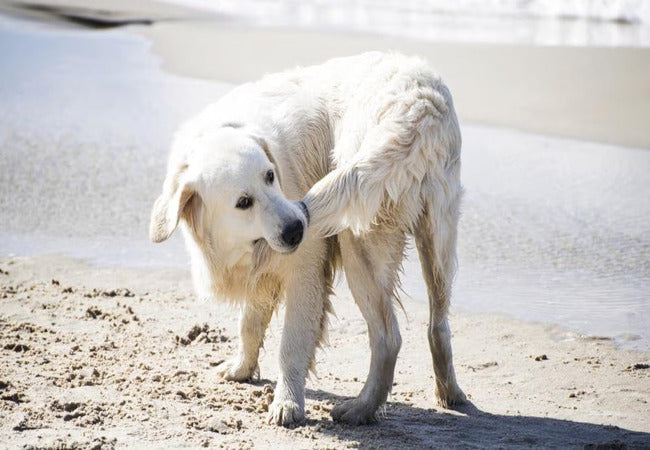Why Dogs Chase Their Tails in 2025 – Vet‑Approved Guide to Play, Boredom & Compulsive Behavior 🐶🔄

In this article
Why Dogs Chase Their Tails in 2025 – Vet‑Approved Guide to Play, Boredom & Compulsive Behavior 🐶🔄
By Dr. Duncan Houston BVSc
Tail‑chasing can be hilarious to watch—but if it’s frequent or destructive, it could be a sign your dog needs help. In this in‑depth 2025 guide, we’ll explore why dogs chase their tails, when it’s harmless, and when it needs attention. With science-backed insights, behavioral tips, and vet support, you'll understand and support your dog’s health and happiness. 😊
1. 🎉 Normal Puppy Play & Body Awareness
Puppies often chase and bite their tails simply to explore their bodies. This playful curiosity is natural and usually fades as they grow.
It’s harmless in short bursts—an entertaining part of puppyhood that builds coordination and self‑awareness.
2. 🧘♂️ Boredom & Attention‑Seeking
Healthy adult dogs chase their tails to burn energy or grab your focus. Whether they’re releasing pent‑up energy or eliciting a laugh, they’ve learned tail chasing can payoff with attention.
This behavior is often reinforced, even by scolding, which unintentionally rewards them with attention.
3. 🩺 Medical Causes & Pain
Persistent tail‑chasing or biting may stem from physical issues:
- 🐾 Fleas, allergies, anal gland problems – discomfort causes focused chewing or chasing.
- 🧠 Nerve pain or injury – a “tingle” or neurological damage can trigger intense interest.
- 🔍 Parasites – tapeworm segments near the anus may encourage tail‑chasing behaviors.
If your dog suddenly begins chasing or biting its tail, especially with fur loss or wound marks, a veterinary exam is essential.
4. 🧠 Compulsive Tail‑Chasing (OCD‑Like Behavior)
Some dogs develop compulsive tail‑chasing—repetitive, intense, and injury‑causing behavior. This is seen commonly in breeds like Bull Terriers, German Shepherds, and Dobermans.
- It may be genetically influenced—linked to CDH2 gene variations.
- Compulsive behaviors often emerge in stressful situations or boredom contexts.
- Severe cases can lead to self‑harm, injuries, even amputation.
5. ⚖️ When Tail‑Chasing Becomes a Problem
Consider veterinary or behavioral intervention if your dog:
- Chases multiple times daily or obsessively
- Injures itself, causing wounds or bleeding
- Bumps into objects during episodes
- Shows stress, pacing, or trouble stopping
These signs suggest the behavior is beyond normal play or boredom.
6. ✅ How to Respond & Support Your Dog
A. Medical Evaluation
- Vet exam includes checking skin, tail nerve function, anal glands, and stool for parasites
- Treat underlying pain or irritation with medication or parasite control
B. Manage Boredom & Energy
- Ensure at least 30–60 minutes of daily activity, varying physical and mental enrichment
- Use puzzle feeders, hide-and-seek games, scent work, training to keep thinking active
C. Remove Unintentional Reinforcement
- Ignore attention‑seeking tail chasing—no talking, scolding, or laughter
- Redirect to calm play, obedience cue (“sit”), or toy, then praise calm behavior
D. Behavior Modification for Compulsive Cases
- Prevent access—e.g. soft tail sock or Elizabethan collar during training period
- Counter-condition: redirect episodes with a food puzzle or safe chew toy
- Consider SSRIs or clomipramine: clinical studies show up to 75% improvement with medication.
7. 📝 Quick Reference Table
| Reason | Signs | Actions |
|---|---|---|
| Puppy play | Irregular, playful tail chasing | Let it fade naturally |
| Boredom/attention | Chasing when alone or seeking your attention | Increase enrichment, ignore episodes |
| Medical pain | Biting, chewing, skin issues | Vet check & treat underlying cause |
| Compulsive disorder | Frequent, injurious, hard to interrupt | Medical + behavior therapy |
8. 📱 Ask A Vet App 2025 Support
Need help diagnosing or managing tail‑chasing behavior? With Ask A Vet you can:
- 📹 Upload video for expert vet/behaviorist review
- 🧩 Receive personalized environmental and medical action plans
- 💬 Chat live with professionals for behavior modification support
Whether it’s a playful puppy or a compulsive adult, support is just a tap away. 🐾📲
❤️ Final Thoughts
Tail‑chasing isn’t always alarming—puppies and playful adults may do it for fun. But frequent or painful episodes should never be ignored. By observing your dog’s behavior, seeking vet input, and applying training strategies, you can ensure your dog stays happy, healthy, and free from unnecessary stress. In 2025, let's balance fun with care—and connect deeply with every tail wag (or chase!). 🐶🔄
Want tailored help? Visit AskAVet.com or download the Ask A Vet app for expert insight and guided care for your dog's tail‑chasing behavior.






